Disinfecting the Skin in Dry Needling: Skin Prep or No Skin Prep?
As a practitioner and instructor of dry needling, I have continually refined my clinical practice based on emerging evidence and a critical assessment of established protocols. The consistent practice of disinfecting the skin in dry needling before needle insertion has frequently been a topic of discussion concerning dry needling methods. During the Foundations in Dry Needling for Orthopedic Rehabilitation and Sports Performance course, a discussion arose regarding the necessity of preparing the skin with alcohol prior to treatment. The maintenance of rigorous hygiene standards is essential; however, the indiscriminate application of disinfectants before dry needling necessitates careful reevaluation. This is particularly relevant given recent research, an enhanced understanding of skin microbiology, and guidelines promoting “best practices” in related procedures.1 Furthermore, academic literature addressing disinfecting the skin in dry needling and acupuncture highlights the contentious aspects of this practice, necessitating a more nuanced examination akin to that presented by Hoffman.2
For years, many practitioners have contested the standard process of cleaning the skin with an alcohol-based solution before the application of single-use sterile needles, including dry needling, mostly influenced by practices from injectable and surgical settings. Nevertheless, the data endorsing this treatment, especially with dry needling, is relatively scant. Furthermore, persuasive evidence indicates that regular disinfection may be superfluous and detrimental in reducing infection risk.
Disinfecting the Skin in Dry Needling: Understanding the Landscape of Infection Risk
Initially, it is essential to contextualize the discussion regarding the actual incidence of infection associated with dry needling. A plethora of studies and reviews have consistently demonstrated that the risk of infection following dry needling is remarkably minimal. A comprehensive study by Brady et al. assessed 17 trials involving more than 11,000 acupuncture and dry needling procedures, revealing a very low infection rate.3 The greatest infection rates reported in the adverse events literature nevertheless demonstrate a very low infection risk of 0.009%.4 The findings strongly suggest that, under standard sanitary circumstances, the probability of causing a clinically relevant infection during dry needling is negligible. This encapsulates the guidelines and rates
found in acupuncture literature, which involves the insertion of single-use needles into the skin. The Council of Colleges of Acupuncture and Herbal Medicine (CCAOM) and acupuncture organizations advocate that the skin must be clean prior to the placement of acupuncture needles. Nonetheless, cleansing the skin with an antiseptic is not inherently requisite for infection prevention.5-9 There are no studies which compare skin preparation prior to acupuncture needle insertion with no skin preparation. The closest information available pertains to skin preparation prior to injections, such as insulin injections for diabetics and vaccinations. Research conducted with diabetic patients indicated that although skin preparation with alcohol prior to injection markedly reduced skin bacterial counts, such treatment is not necessary to prevent infection at injection sites.8 Many authors discuss cleaning the skin with soap and water prior to acupuncture or dry needling without evident dirt or skin injury.5-9 It has been mentioned that excessive cleaning can compromise the skin’s integrity.2
It is crucial to acknowledge that infection rates might vary based on factors like patient health, needle sterility, and practitioner skill; yet, the remarkably low baseline risk necessitates a cautious evaluation of interventions like frequent cleaning.
Disinfecting the Skin in Dry Needling: The Limited Microbicidal Effect
The preparation of the skin prior to dry needling has frequently been based on imprecise pre-injection methods, which have faced criticism. The principal aim of skin preparation is typically regarded as sterilizing the skin and minimizing the danger of infection; yet, this perspective is predominantly theoretical and remains contentious.2 The commonly utilized chemical, often alcohol, demonstrates a fast microbicidal impact against surface microorganisms; nevertheless, its effectiveness is limited by its volatility, leading to evaporation before to achieving its maximum potential.2 Hoffman highlights that “the volatility of alcohol presents both benefits and drawbacks; it evaporates swiftly, rendering it convenient for use, yet even a rapid disinfectant has limited opportunity to exert its full efficacy within the ten to twenty seconds between application and evaporation.”2
Moreover, it is essential to note that the skin contains a resident microbial population inhabiting the ducts, glands, and follicles, which are inaccessible to disinfectants. Hoffman further clarifies, “Numerous microbial populations of the skin reside beneath the surface…” This concealed microbial population will remain impervious to any disinfectant employed. The research proved the impossibility of effectively sterilizing skin, as seen by biopsies taken from cadaver skin. None of the samples exhibited a total lack of bacterial growth following extended disinfection.2. In essence, even with disinfection, we are not achieving true sterility, and the deeper microbial residents remain untouched, potentially taken into deeper tissues by the needle.
The Possible Double-Edged Sword of Disinfecting the Skin in Dry Needling
Hoffman notes that the likelihood of infections arising from sterile needle penetration through intact skin in individuals with uncompromised immunity is quite rare. This is due to the fact that most infections following sterile needle penetration are linked to Staphylococcus aureus, and Staphylococcal infections require the introduction of over 7,500,000 organisms to initiate an infection, a quantity rarely present after standard cleansing procedures.2
The principal justification of disinfecting the skin in dry needling is to diminish the bacterial burden on the skin’s surface, hence reducing the danger of pathogen introduction during needle insertion. Nonetheless, this ostensibly simple reasoning neglects the complex interactions among skin microbiology, skin barrier function, and the mechanisms underlying dry needling. The skin’s surface is not sterile; it comprises a complex ecosystem inhabited by a broad array of bacteria known as the skin microbiota. The indigenous bacteria, fungi, and viruses are crucial for sustaining skin homeostasis, modulating immunological responses, and inhibiting the colonization of harmful microorganisms.6
Disinfection aims to eradicate ephemeral germs; however, it accidentally disturbs the skin microbiota, potentially leading to an imbalance and allowing more virulent or opportunistic pathogens to proliferate. Moreover, the disinfection process may undermine the stratum corneum’s integrity, the epidermis’s outermost layer, which serves as the principal barrier against external hazards. While alcohol-based disinfectants effectively diminish bacterial load, they can also cause dryness and damage to the stratum corneum, leading to microscopic abrasions and heightened permeability sensitivity.7 These tiny alterations can significantly enhance the likelihood of bacterial colonization in the body, in contrast to unaltered skin, which possesses its own innate defenses. It is important to recognize that disinfecting the skin in dry needling may unintentionally drive surface pollutants deeper into the hair follicles, sebaceous glands, and ducts prior to needle penetration.2
The Importance of Aseptic Technique and Standard Precautions
Employing aseptic approach during skin puncture is essential. In light of the aforementioned problems, I propose prioritizing aseptic technique and compliance with standard precautions as the foundation of infection prevention in dry needling, rather than depending on routine skin disinfection as a key strategy. This reflects the sentiment articulated in the WHO’s “Best Infection Control Practices” document.1 The paper aims to eliminate injections, and its idea of limiting unneeded interventions corresponds with the scrutiny of routine skin cleaning in dry needling. Aseptic technique involves a series of activities designed to reduce the introduction of germs at the treatment site. These include:
· Strict Hand Hygiene: It is imperative to engage in thorough hand washing with soap and water or to utilize an alcohol-based hand rub before and after each treatment, as this is non-negotiable.
· Use of Sterile Needles: The employment of single-use, pre-sterilized needles is of paramount importance. The integrity of the packaging must be meticulously inspected prior to use. This requirement is further emphasized by the WHO paper, which states the necessity for sterile injection equipment.1
· Clean Field, Clean Instruments, Clean Hands: It is essential to ensure that all instruments and the treatment environment are devoid of visible contamination.
· Gloves (Selective Use): The utilization of disposable gloves is recommended when there is a risk of contact with blood or other bodily fluids. In routine dry needling, where the risk of such contact is minimal, the use of gloves may not be obligatory; however, they should be employed to mitigate exposure.
The WHO article even includes that gloves are unnecessary when treating intact skin and points out that unsafe techniques may expose people to infection.1
It is essential to recognize that, while I do not advocate for routine disinfection with alcohol, I do not entirely dismiss its applicability. In particular circumstances where the skin is visibly soiled or when addressing patients with compromised immune systems, disinfection may be warranted. However, in the majority of cases, the body’s natural defenses, in conjunction with proper hygiene practices implemented by the provider, should suffice.
When to Consider Disinfecting the Skin in Dry Needling
While the case against routine disinfection is strong, specific circumstances may warrant a more cautious approach:
· Visibly Contaminated Skin: In instances where the skin at the treatment site is visibly contaminated (e.g., dirt, sweat, debris), it is advisable to perform a gentle cleaning using soap and water, followed by disinfection with an alcohol-based solution.
· Compromised Immune System: Individuals with compromised immune systems (e.g., those diagnosed with HIV, cancer, or those on immunosuppressant medications) may exhibit increased susceptibility to infections. Therefore, in such cases, skin disinfection is a prudent precautionary measure.
· Open Wounds or Broken Skin: The practice of dry needling is contraindicated on sites where the skin is open, broken, or affected by wounds.
Moving Forward: Evidence-Based Decision-Making: Disinfecting the Skin in Dry Needling
The discourse regarding disinfecting the skin in dry needling emphasizes the significance of evidence-based decision-making within clinical practice. While it may be tempting to adhere to established protocols, it is imperative to critically assess the evidence and adapt our practices in accordance with emerging information to ensure optimal patient care. The WHO report accentuates the necessity of relying on robust research to inform best practices.
I contend that shifting away from routine disinfecting the skin in dry needling, in favor of rigorous aseptic techniques and selective disinfection based on individual patient considerations, represents a more rational and evidence-based approach to infection control. Additional research is required to comprehensively elucidate the impact of varying skin preparation strategies on infection rates and patient outcomes. Nevertheless, drawing from the extant data and a more profound understanding of skin microbiology, I am confident that prioritizing aseptic techniques and prudent disinfection constitutes the safest and most effective course of action moving forward. If you would like to learn more about dry needling and evidence based approaches to its use, I suggest attending one of our dry needling courses near you.
References
- Hutin, Y., Hauri, A., Chiarello, L., Catlin, M., Stilwell, B., Ghebrehiwet, T., Garner, J., & Members of the Injection Safety Best Practices Development Group. (2003). Best infection control practices for intradermal, subcutaneous, and intramuscular needl
- Hoffman, P. (2001). Skin Disinfection and Acupuncture. Acupuncture in Medicine, 19(2), 112-116.
- Brady, S., Dean, S., Skinner, A., & Hannan, I. (2013). Adverse events following dry needling: a systematic review. Journal of Evaluation in Clinical Practice, 19(3), 357-375.
- Boyce, David, Hannah Wempe, Courtney Campbell, Spencer Fuehne, Edo Zylstra, Grant Smith, Christopher Wingard, and Richard Jones. “ADVERSE EVENTS ASSOCIATED WITH THERAPEUTIC DRY NEEDLING.” International Journal of Sports Physical Therapy 15, no. 1 (Februaryhttps://doi.org/10.26603/ijspt20200103.
- Given, S. (2009). Clean needle technique manual for acupuncturists; Guidelines and standards for the clean and safe clinical practice of acupuncture (7th ed.). Chaplin: National Acupuncture Foundation.
- Byrd, A. L., Belkaid, Y., & Segre, J. A. (2018). The human skin microbiome. Nature Reviews Microbiology, 16(3), 143-155.
- Proksch, E., Brandner, J. M., & Jensen, J. M. (2008). The skin: an indispensable barrier. Experimental Dermatology, 17(12), 1063-1072.
- McCarthy JA, Covarrubias B, Sink P. Is the Traditional Alcohol Wipe Necessary Before an Insulin Injection?: Dogma disputed. Diabetes Care. 1993;16(1):402-402. doi:10.2337/diacare.16.1.402a
- https://www.ccahm.org/images/ccaom/Documents/Position-Papers/Position_Paper_re_Skin_Preparation_(Final).pdf




